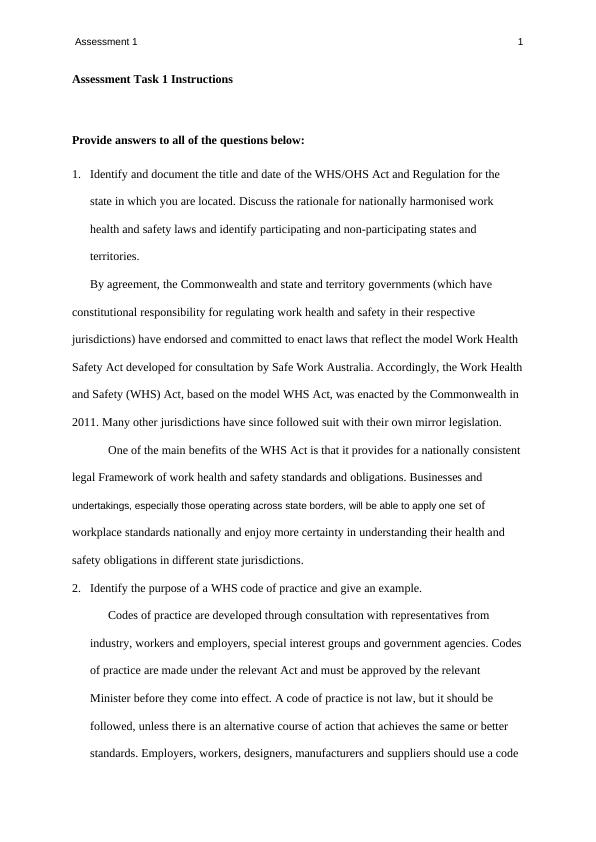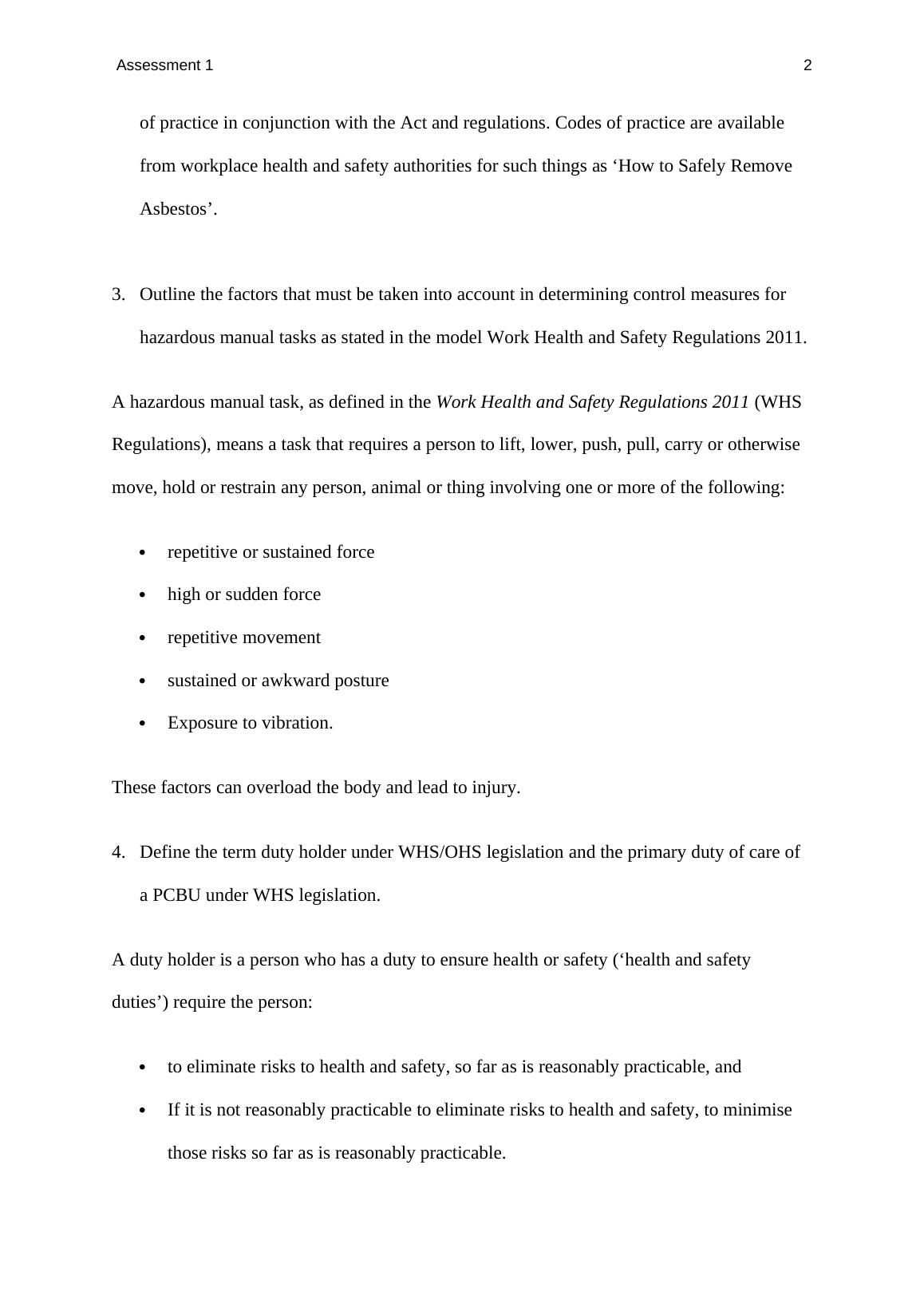Work Health and Safety Laws Doc
9 Pages1551 Words97 Views
Added on 2020-05-08
Work Health and Safety Laws Doc
Added on 2020-05-08
ShareRelated Documents
Assessment 1 1
Assessment Task 1 Instructions
Provide answers to all of the questions below:
1. Identify and document the title and date of the WHS/OHS Act and Regulation for the
state in which you are located. Discuss the rationale for nationally harmonised work
health and safety laws and identify participating and non-participating states and
territories.
By agreement, the Commonwealth and state and territory governments (which have
constitutional responsibility for regulating work health and safety in their respective
jurisdictions) have endorsed and committed to enact laws that reflect the model Work Health
Safety Act developed for consultation by Safe Work Australia. Accordingly, the Work Health
and Safety (WHS) Act, based on the model WHS Act, was enacted by the Commonwealth in
2011. Many other jurisdictions have since followed suit with their own mirror legislation.
One of the main benefits of the WHS Act is that it provides for a nationally consistent
legal Framework of work health and safety standards and obligations. Businesses and
undertakings, especially those operating across state borders, will be able to apply one set of
workplace standards nationally and enjoy more certainty in understanding their health and
safety obligations in different state jurisdictions.
2. Identify the purpose of a WHS code of practice and give an example.
Codes of practice are developed through consultation with representatives from
industry, workers and employers, special interest groups and government agencies. Codes
of practice are made under the relevant Act and must be approved by the relevant
Minister before they come into effect. A code of practice is not law, but it should be
followed, unless there is an alternative course of action that achieves the same or better
standards. Employers, workers, designers, manufacturers and suppliers should use a code
Assessment Task 1 Instructions
Provide answers to all of the questions below:
1. Identify and document the title and date of the WHS/OHS Act and Regulation for the
state in which you are located. Discuss the rationale for nationally harmonised work
health and safety laws and identify participating and non-participating states and
territories.
By agreement, the Commonwealth and state and territory governments (which have
constitutional responsibility for regulating work health and safety in their respective
jurisdictions) have endorsed and committed to enact laws that reflect the model Work Health
Safety Act developed for consultation by Safe Work Australia. Accordingly, the Work Health
and Safety (WHS) Act, based on the model WHS Act, was enacted by the Commonwealth in
2011. Many other jurisdictions have since followed suit with their own mirror legislation.
One of the main benefits of the WHS Act is that it provides for a nationally consistent
legal Framework of work health and safety standards and obligations. Businesses and
undertakings, especially those operating across state borders, will be able to apply one set of
workplace standards nationally and enjoy more certainty in understanding their health and
safety obligations in different state jurisdictions.
2. Identify the purpose of a WHS code of practice and give an example.
Codes of practice are developed through consultation with representatives from
industry, workers and employers, special interest groups and government agencies. Codes
of practice are made under the relevant Act and must be approved by the relevant
Minister before they come into effect. A code of practice is not law, but it should be
followed, unless there is an alternative course of action that achieves the same or better
standards. Employers, workers, designers, manufacturers and suppliers should use a code

Assessment 1 2
of practice in conjunction with the Act and regulations. Codes of practice are available
from workplace health and safety authorities for such things as ‘How to Safely Remove
Asbestos’.
3. Outline the factors that must be taken into account in determining control measures for
hazardous manual tasks as stated in the model Work Health and Safety Regulations 2011.
A hazardous manual task, as defined in the Work Health and Safety Regulations 2011 (WHS
Regulations), means a task that requires a person to lift, lower, push, pull, carry or otherwise
move, hold or restrain any person, animal or thing involving one or more of the following:
repetitive or sustained force
high or sudden force
repetitive movement
sustained or awkward posture
Exposure to vibration.
These factors can overload the body and lead to injury.
4. Define the term duty holder under WHS/OHS legislation and the primary duty of care of
a PCBU under WHS legislation.
A duty holder is a person who has a duty to ensure health or safety (‘health and safety
duties’) require the person:
to eliminate risks to health and safety, so far as is reasonably practicable, and
If it is not reasonably practicable to eliminate risks to health and safety, to minimise
those risks so far as is reasonably practicable.
of practice in conjunction with the Act and regulations. Codes of practice are available
from workplace health and safety authorities for such things as ‘How to Safely Remove
Asbestos’.
3. Outline the factors that must be taken into account in determining control measures for
hazardous manual tasks as stated in the model Work Health and Safety Regulations 2011.
A hazardous manual task, as defined in the Work Health and Safety Regulations 2011 (WHS
Regulations), means a task that requires a person to lift, lower, push, pull, carry or otherwise
move, hold or restrain any person, animal or thing involving one or more of the following:
repetitive or sustained force
high or sudden force
repetitive movement
sustained or awkward posture
Exposure to vibration.
These factors can overload the body and lead to injury.
4. Define the term duty holder under WHS/OHS legislation and the primary duty of care of
a PCBU under WHS legislation.
A duty holder is a person who has a duty to ensure health or safety (‘health and safety
duties’) require the person:
to eliminate risks to health and safety, so far as is reasonably practicable, and
If it is not reasonably practicable to eliminate risks to health and safety, to minimise
those risks so far as is reasonably practicable.

Assessment 1 3
PCBU duty- A PCBU, through its officers, has a duty under the WHS Act to consult with
workers at all levels of the business. Senior leaders and managers should promote and foster
open lines of communication and consultation with workers. This can be achieved by:
Creating and nurturing joint partnerships with:
o workplace work groups
o HSRs and employee representative
o Other involved PCBUs.
Ensuring effective consultation processes are built in to the business through its
systems, policies and procedures.
Engage with workers by being visible and open to feedback and ideas.
5. Outline two examples of a WHS policy that a business may implement.
i. Insurance for all employees in the workplace to cover them in case
of any risks or incidents that might lead to an economic or
equivalent loss.
ii. WHS Policy 62 – Manual handling - All tasks involving manual
handling must be risk assessed and controlled. Responsibilities for
all levels of employees and management must be identified,
communicated and discharged effectively by all concerned.
Equipment will be provided to assist in manual handling where a
need is identified as part of a control measure. This equipment will
be used appropriately and maintained well at all times with all
operators certified where this is required under law.
6. Explain the process of risk assessment and control in workplace health and safety.
Managing WHS risks involves four steps:
PCBU duty- A PCBU, through its officers, has a duty under the WHS Act to consult with
workers at all levels of the business. Senior leaders and managers should promote and foster
open lines of communication and consultation with workers. This can be achieved by:
Creating and nurturing joint partnerships with:
o workplace work groups
o HSRs and employee representative
o Other involved PCBUs.
Ensuring effective consultation processes are built in to the business through its
systems, policies and procedures.
Engage with workers by being visible and open to feedback and ideas.
5. Outline two examples of a WHS policy that a business may implement.
i. Insurance for all employees in the workplace to cover them in case
of any risks or incidents that might lead to an economic or
equivalent loss.
ii. WHS Policy 62 – Manual handling - All tasks involving manual
handling must be risk assessed and controlled. Responsibilities for
all levels of employees and management must be identified,
communicated and discharged effectively by all concerned.
Equipment will be provided to assist in manual handling where a
need is identified as part of a control measure. This equipment will
be used appropriately and maintained well at all times with all
operators certified where this is required under law.
6. Explain the process of risk assessment and control in workplace health and safety.
Managing WHS risks involves four steps:

End of preview
Want to access all the pages? Upload your documents or become a member.
Related Documents
Ensure a Safe Workplace for a Work Arealg...
|8
|1539
|75
Implement and Monitor WHS Policies, Procedures and Programslg...
|7
|1917
|70
OHS/WHS Policies, Duty Holder Responsibilities, Hierarchy of Control, Quality System and WHS Record Keepinglg...
|16
|3901
|95
Improving the Role of Legislators in Implementing Lawslg...
|5
|666
|28
Ensure a Safe Workplace - Assignmentlg...
|14
|3192
|820
(HLTWHS004)-Manage Work Health and Safety: Impact of State Legislation and Regulationslg...
|15
|3073
|319
